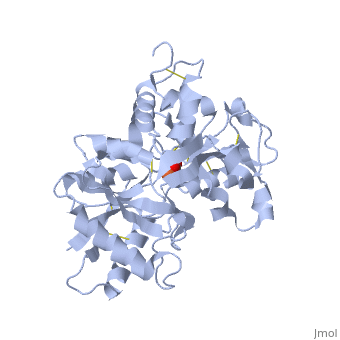1dtg
From Proteopedia
| Line 4: | Line 4: | ||
|PDB= 1dtg |SIZE=350|CAPTION= <scene name='initialview01'>1dtg</scene>, resolution 2.4Å | |PDB= 1dtg |SIZE=350|CAPTION= <scene name='initialview01'>1dtg</scene>, resolution 2.4Å | ||
|SITE= | |SITE= | ||
| - | |LIGAND= <scene name='pdbligand= | + | |LIGAND= <scene name='pdbligand=CO3:CARBONATE+ION'>CO3</scene>, <scene name='pdbligand=FE:FE+(III)+ION'>FE</scene> |
|ACTIVITY= | |ACTIVITY= | ||
|GENE= | |GENE= | ||
| + | |DOMAIN= | ||
| + | |RELATEDENTRY= | ||
| + | |RESOURCES=<span class='plainlinks'>[http://oca.weizmann.ac.il/oca-docs/fgij/fg.htm?mol=1dtg FirstGlance], [http://oca.weizmann.ac.il/oca-bin/ocaids?id=1dtg OCA], [http://www.ebi.ac.uk/pdbsum/1dtg PDBsum], [http://www.rcsb.org/pdb/explore.do?structureId=1dtg RCSB]</span> | ||
}} | }} | ||
| Line 14: | Line 17: | ||
==Overview== | ==Overview== | ||
Serum transferrin is the major iron transport protein in humans. Its function depends on its ability to bind iron with very high affinity, yet to release this bound iron at the lower intracellular pH. Possible explanations for the release of iron from transferrin at low pH include protonation of a histidine ligand and the existence of a pH-sensitive "trigger" involving a hydrogen-bonded pair of lysines in the N-lobe of transferrin. We have determined the crystal structure of the His249Glu mutant of the N-lobe half-molecule of human transferrin and compared its iron-binding properties with those of the wild-type protein and other mutants. The crystal structure, determined at 2.4 A resolution (R-factor 19.8%, R(free) 29.4%), shows that Glu 249 is directly bound to iron, in place of the His ligand, and that a local movement of Lys 296 has broken the dilysine interaction. Despite the loss of this potentially pH-sensitive interaction, the H249E mutant is only slightly more acid-stable than wild-type and releases iron slightly faster. We conclude that the loss of the dilysine interaction does make the protein more acid stable but that this is counterbalanced by the replacement of a neutral ligand (His) by a negatively charged one (Glu), thus disrupting the electroneutrality of the binding site. | Serum transferrin is the major iron transport protein in humans. Its function depends on its ability to bind iron with very high affinity, yet to release this bound iron at the lower intracellular pH. Possible explanations for the release of iron from transferrin at low pH include protonation of a histidine ligand and the existence of a pH-sensitive "trigger" involving a hydrogen-bonded pair of lysines in the N-lobe of transferrin. We have determined the crystal structure of the His249Glu mutant of the N-lobe half-molecule of human transferrin and compared its iron-binding properties with those of the wild-type protein and other mutants. The crystal structure, determined at 2.4 A resolution (R-factor 19.8%, R(free) 29.4%), shows that Glu 249 is directly bound to iron, in place of the His ligand, and that a local movement of Lys 296 has broken the dilysine interaction. Despite the loss of this potentially pH-sensitive interaction, the H249E mutant is only slightly more acid-stable than wild-type and releases iron slightly faster. We conclude that the loss of the dilysine interaction does make the protein more acid stable but that this is counterbalanced by the replacement of a neutral ligand (His) by a negatively charged one (Glu), thus disrupting the electroneutrality of the binding site. | ||
| - | |||
| - | ==Disease== | ||
| - | Known diseases associated with this structure: Atransferrinemia OMIM:[[http://www.ncbi.nlm.nih.gov/entrez/dispomim.cgi?id=190000 190000]], Iron deficiency anemia, susceptibility to OMIM:[[http://www.ncbi.nlm.nih.gov/entrez/dispomim.cgi?id=190000 190000]] | ||
==About this Structure== | ==About this Structure== | ||
| Line 30: | Line 30: | ||
[[Category: Mason, A B.]] | [[Category: Mason, A B.]] | ||
[[Category: Smith, C A.]] | [[Category: Smith, C A.]] | ||
| - | [[Category: CO3]] | ||
| - | [[Category: FE]] | ||
[[Category: 3d- structure]] | [[Category: 3d- structure]] | ||
[[Category: glycoprotein]] | [[Category: glycoprotein]] | ||
| Line 40: | Line 38: | ||
[[Category: signal]] | [[Category: signal]] | ||
| - | ''Page seeded by [http://oca.weizmann.ac.il/oca OCA ] on | + | ''Page seeded by [http://oca.weizmann.ac.il/oca OCA ] on Sun Mar 30 19:48:23 2008'' |
Revision as of 16:48, 30 March 2008
| |||||||
| , resolution 2.4Å | |||||||
|---|---|---|---|---|---|---|---|
| Ligands: | , | ||||||
| Resources: | FirstGlance, OCA, PDBsum, RCSB | ||||||
| Coordinates: | save as pdb, mmCIF, xml | ||||||
HUMAN TRANSFERRIN N-LOBE MUTANT H249E
Overview
Serum transferrin is the major iron transport protein in humans. Its function depends on its ability to bind iron with very high affinity, yet to release this bound iron at the lower intracellular pH. Possible explanations for the release of iron from transferrin at low pH include protonation of a histidine ligand and the existence of a pH-sensitive "trigger" involving a hydrogen-bonded pair of lysines in the N-lobe of transferrin. We have determined the crystal structure of the His249Glu mutant of the N-lobe half-molecule of human transferrin and compared its iron-binding properties with those of the wild-type protein and other mutants. The crystal structure, determined at 2.4 A resolution (R-factor 19.8%, R(free) 29.4%), shows that Glu 249 is directly bound to iron, in place of the His ligand, and that a local movement of Lys 296 has broken the dilysine interaction. Despite the loss of this potentially pH-sensitive interaction, the H249E mutant is only slightly more acid-stable than wild-type and releases iron slightly faster. We conclude that the loss of the dilysine interaction does make the protein more acid stable but that this is counterbalanced by the replacement of a neutral ligand (His) by a negatively charged one (Glu), thus disrupting the electroneutrality of the binding site.
About this Structure
1DTG is a Single protein structure of sequence from Homo sapiens. Full crystallographic information is available from OCA.
Reference
Mutation of the iron ligand His 249 to Glu in the N-lobe of human transferrin abolishes the dilysine "trigger" but does not significantly affect iron release., MacGillivray RT, Bewley MC, Smith CA, He QY, Mason AB, Woodworth RC, Baker EN, Biochemistry. 2000 Feb 15;39(6):1211-6. PMID:10684598
Page seeded by OCA on Sun Mar 30 19:48:23 2008

